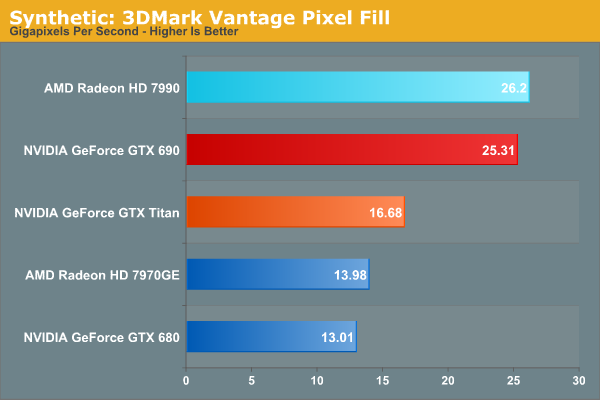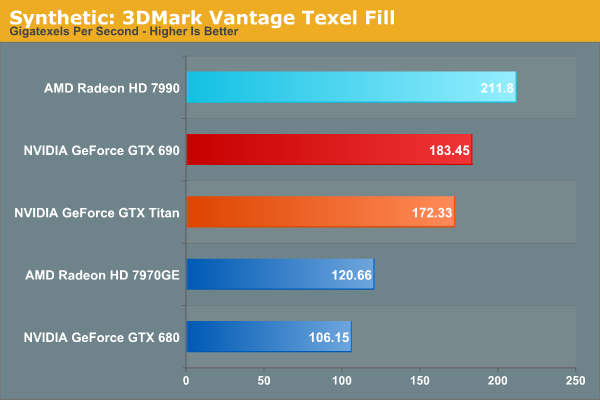AMD Radeon HD 7990 Review: 7990 Gets Official
by Ryan Smith on April 24, 2013 12:01 AM EST- Posted in
- GPUs
- AMD
- Radeon
- Radeon HD 7000
- Tahiti
Synthetics
As always we’ll also take a quick look at synthetic performance, though as a multi-GPU card using a known GPU, there shouldn't be any surprises here. These tests are mostly for comparing cards from within a manufacturer, as opposed to directly comparing AMD and NVIDIA cards. We’ll start with 3DMark Vantage’s Pixel Fill test.

There’s not much to say here. So long as the 7990 isn’t throttling, its ROP/memory performance is almost twice that of the 7970GE, reflecting the fact that the two cards’ clockspeeds are so close.
Moving on, we have our 3DMark Vantage texture fillrate test, which does for texels and texture mapping units what the previous test does for ROPs.

Texture fillrates are the same story as pixel fillrates: the 7990 is an extremely capable card.
Finally we’ll take a quick look at tessellation performance with TessMark.

And again, we're seeing almost perfect scaling from the 7970GE to the 7990 in our synthetic tests.










91 Comments
View All Comments
HisDivineOrder - Wednesday, April 24, 2013 - link
They bring a fantastic cooler that prioritizes silence and convenience to have SLI in a system that doesn't have two PCIe slots available for them. Plus, you always had the option of quad-SLI that's a little harder to do with four 680's.That said, I think anyone buying a 690 over a Titan now is pretty stupid. It's not about the speed difference. It's that if you're in the market for a $1k GPU, go for the one that won't be running out of memory with next year's PS4/next Xbox ports.
extremesheep - Wednesday, April 24, 2013 - link
Table typo...should the first be "7990"?extremesheep - Wednesday, April 24, 2013 - link
Err...should page 1, table 1, column 1 be "7990" instead of "7970"?Ryan Smith - Wednesday, April 24, 2013 - link
You may be seeing an old, cached copy. That was fixed about 25 minutes ago.code65536 - Wednesday, April 24, 2013 - link
Any chance we could get Tomb Raider in future benchmark tests?Ryan Smith - Wednesday, April 24, 2013 - link
In the desktop tests? No. We keep the tests capped at 10 so that it's a manageable load when we need to redo everything, such as with the 7990 launch. At this point the desktop benchmark suite is set for at least the immediate future.VulgarDisplay - Wednesday, April 24, 2013 - link
4th paragraph: Incorrectly stated that Tahiti has 48 rops.Flamencor - Wednesday, April 24, 2013 - link
What a mediocre review! In your conclusions, you mention nothing about how AMD absolutely spanked NVIDIA in compute performance and synthetics! It is 75 watts more power hungry, and in exchange you get substantially more memory and a total win on compute and synthetics! I know synthetics aren't actual gaming numbers, but they're indicative of how the card will stand up to future games. The fact that the card has far better synthetics says a lot about it's longevity. The card looks like a great card (although quite late)! I'm no fanboy, but why can't people just write a legitimately upbeat and positive review about an amazing part?Warren21 - Wednesday, April 24, 2013 - link
Ryan typically has a slight undertone of NVIDIA bias; it can be found in most of his articles. That being said, the GTX 600 series are some amazing cards. I'd love to have a GK104-based card to replace my aged 6870 1GB.CiccioB - Wednesday, April 24, 2013 - link
This kind of compute benchmarks based on OpenCL are quite useless. No professional applications use OpenCL and nvidia doesn't really put all its efforts in optimizing their OpenCL drivers.You may be surprise to know that REAL applications that really need GPU assisted computation use CUDA. And thus you have the option to use nvidia GPU computation or nothing else.
That's for how good is OpenCL. It may be open, it may be something AMD needs to show good (useless) graphs, but in real word none is going to use it for serious stuff.
3D renderers are a meaningful example: apart the useless SmallLuxMark benchmark, professional engines use CUDA. AMD is not there with whatever "devasting" computational solution you may believe they have. That's why nvidia holds more than 80% of the professional market and it's the only one having GPUs solutions for HPC while AMD just struggles to sell consumer products.
By the way, goo review, though a double Titan solution may have been added to make it more interesting (especially for power consumption) :)